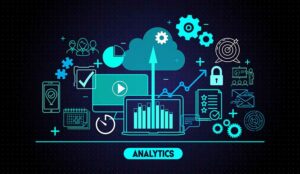Data collection is a more vital component in the success of a business than ever before. A vast 72% of marketing companies collect customer data through their websites, but what do they do with it?
Customer data equips businesses with valuable information so they can learn more about target audiences, improve customer journeys, enhance customer service and drive business revenue.
Call centres must deliver exceptional customer experiences and high customer satisfaction levels to gain repeat business.
Read on to learn more about call centre analytics and how your contact centre can unlock the power of data to help you attract new customers, retain existing ones and rise above your competitors.
What Are Call Centre Analytics?
Call centre analytics refers to the process of gathering and analysing all-important customer data. This is achieved through different analytics tools to monitor various KPIs. The end goal of analytics solutions is to keep call centre agent performance high and reduce customer churn.
To measure contact centre analytics, you must investigate important customer data metrics, such as call volume, customer engagement, first call resolution and retention rates. This data can be collected via omnichannel routes and explores customer touchpoints to identify opportunities to optimise customer journeys.
The Advantages of Call Centre Analytics
Improved customer service and retention rates aside, the other advantages of call centre analytics include:
- Being able to establish the root cause of agent performance rates
- Increasing inbound sales call volumes
- Improving contact centre operations
- Reducing average handling time for calls
- Understanding customer sentiment
- Making accurate decisions using actionable insights
Having covered why call centre data analytics should be part of your business plan, let’s check out six different analytics approaches that hold the key to the best results for your customer call centre.
Speech Analytics
Speech analytics from both agent and customer perspectives garner some of the best data. This analytics approach monitors customer calls in real-time to identify common troublesome touchpoints in calls.
For example, businesses may choose to adopt different call scripts to navigate a smoother IVR customer experience. Speech analytics uses machine learning to identify negative and positive keywords during call centre conversations.
Speech analytics even measure voice tones and how often customer agents speak during calls. This data gives direct feedback to agents and provides meaningful details about call interactions to improve customer service.
Text Analytics
Text analytics may encompass data gathered from customer interactions on social media channels. Additional data sources could include monitoring email communications to review all text interactions.
Text analytics tools collect data from these omnichannel communications and, using AI technology, identify key insights that reflect customer satisfaction scores.
While analysing customer text data, you may realise that customers want to use self-service options for updating address information. If this is the case, you can analyse text for keywords customers commonly use and tailor your content to match the language they’re used to.
This all leads to better decision-making strategies about your business’s future operational plans.
Predictive Analytics
Predictive analytics work by analysing historical customer behaviour data. Combining metrics such as call volume, customer satisfaction, and first call resolution rates builds a picture of predicted user behaviour.
Predictive analytics are effective at determining customer intent. By analysing keywords, previous buying behaviour and contact centre interactions, you could even predict how customers will respond to a potential follow-up call.
Wouldn’t it be great to forecast the probability of a sale based on these metrics? It’s possible with predictive analytics, allowing customer agents to concentrate on the warmest leads and maximise their time.
Using predictive analytics also gives your business the insight to plan staff schedules for seasonal upticks and forecast how well product launches might be received.
Self-Service Analytics
If your business offers customers the option to use self-service for their enquiries, then (as well as reducing the time spent with support agents) you’ll have access to reams of customer data. Self-service examples include chatbots, artificial intelligence interactions and order tracking functions.
Once you know the areas where customers want to self-serve, create FAQs within your content to answer common questions and take pressure off busy customer support agents.
By using text and speech analytics tools, you can make your existing self-service tools more efficient and accurate.
Desktop Analytics
Desktop analytics is perhaps the pinnacle of advanced analytics tools. Monitoring computer dashboards, desktop analytics allow for complete insight into each agent’s calls, overall performance and software operations.
Desktop analytics help your business to answer questions such as:
- How much time do agents spend on software elements?
- Which applications do top-performing agents browse?
- Are agents following the training tools provided?
- Do agents have all the information they require to provide quick responses?
- Which websites do agents use to support customers’ experiences?
Answering these questions provides brilliant training opportunities and allows for the creation of useful tools to make agents more efficient.
Real-time desktop analytics have the potential to enhance customer experiences, reduce customer frustrations and optimise the entire call centre process.
Cross-Channel Analytics
Cross-channel analytics empower call centres with data demonstrating the different channels customers choose for interactions. These insights increase service levels and streamline operations, so you can focus on optimising the most-used channels.
Channels to explore include:
- Telephone
- Instant messaging
- Social media
- Chat
- Direct feedback
Customer service agents can tailor their responses to individual customers based on these cross-channel data sources. Customers will always choose the most convenient method of communication. By understanding this, and being aware of the channels customers prefer, you can meet them where they are.
How to Implement a Call Centre Analytics Programme
Any call centre analytics programme must be implemented with support from key members of the company to ensure everyone is on the same page. To set off on the right foot with your real-time analytics plan, you should do the following.
Create Dashboards to Swiftly Communicate Crucial Points
Consider the devices and applications staff members will use to access your call centre analytics. It makes sense for all parties to use dashboards that provide clear context and any essential information.
Present Information, Not Data
Following on from providing clear context, be sure to present accurate information to assist with decision-making processes. Strive to deliver this in interactive ways to encourage maximum engagement from team members. There are multiple stages to an analytics programme, and data is for analysis further down the line.
Timely Analysis Is Required
Using intuitive dashboards, create tasks that are time-sensitive so contact centre managers understand their responsibilities. Doing this focuses attention in the right places and ensures data is gathered promptly so the next stage can be completed on time.
Users Need Control
When setting tasks, ensure different team members know their goals and role requirements. This sets clear parameters and allows for staff members to focus on their own projects. Look for analytics software that sets user permissions for managers and different staff members.
Consider Your Objectives as a Whole, From the Standpoint of Your Entire Company
Take a step back and assess your business objectives before embarking on your call centre analytics programme. The metrics measured during the analytics process will depend on your overall business goals.
Perhaps you’re aiming to increase your first call resolution rate and improve call centre agent productivity? In which case, make sure this metric is clearly defined as part of the analytics process.
Getting Started With Call Centre Analytics
There are three stages to getting started with call centre analytics:
- Collection
- Analysis
- Action
First things first, you should organise how data collection is going to work. Enlist your team and strategically plan the data sources you’ll work with, get the right software in place to make life easier and ensure your processes are as streamlined as possible.
Legacy phone systems aren’t going to help your analytics programme in the slightest, so consider cloud-based options that assist with data collection intuitively while allowing agents to do their jobs better.
One strategy is to create hypotheses. For instance, calls that commonly drop off at certain points throughout the call time could mean on-hold information is inadequate. Check the data against this theory to either prove or disprove it.
Consider the right analytics platform for your business needs. This means nailing your business objectives and ensuring the analytics platform is fit for purpose, with simple navigation and display features that all your team can access and easily understand.
When harnessed correctly, call centre analytics are a powerful tool. However, providing actionable insights is only valuable if you’re willing to make adjustments to your business model.
It’s important to face the results from your call centre analytics endeavours, as they won’t always be pretty. For example, it can be difficult to hear accurate customer data results and make the necessary changes.
But remember, it’s for the good of your business. After all, as Einstein famously said, “insanity is doing the same thing over and over and expecting different results.” Make changes based on hard data, and see your business flourish.
Author: Guest Author
Published On: 5th May 2022
Read more about - Guest Blogs, RingCentral


































